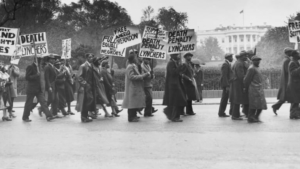Historians expose early scientists’ debt to the slave trade
Image: Hans Sloane collected this specimen of cacao in Jamaica in the 1680s. Sloane often collected on or near slave plantations, taking advantage of slavery’s infrastructure to advance his science. (NHM Images)
(ScienceMag.org) At the dawn of the 1700s, European science seemed poised to conquer all of nature. Isaac Newton had recently published his monumental theory of gravity. Telescopes were opening up the heavens to study, and Robert Hooke and Antonie van Leeuwenhoek’s microscopes were doing the same for the miniature world. Fantastic new plants and animals were pouring in from Asia and the Americas. But one of the most important scientists alive then was someone few people have ever heard of, an apothecary and naturalist named James Petiver. And he was important for a startling reason: He had good connections within the slave trade.
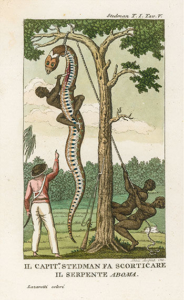 Although he rarely left London, Petiver ran a global network of dozens of ship surgeons and captains who collected animal and plant specimens for him in far-flung colonies. Petiver set up a museum and research center with those specimens, and he and visiting scientists wrote papers that other naturalists (including Carl Linnaeus, the father of taxonomy) drew on. Between one-quarter and one-third of Petiver’s collectors worked in the slave trade, largely because he had no other options: Few ships outside the slave trade traveled to key points in Africa and Latin America. Petiver eventually amassed the largest natural history collection in the world, and it never would have happened without slavery.
Although he rarely left London, Petiver ran a global network of dozens of ship surgeons and captains who collected animal and plant specimens for him in far-flung colonies. Petiver set up a museum and research center with those specimens, and he and visiting scientists wrote papers that other naturalists (including Carl Linnaeus, the father of taxonomy) drew on. Between one-quarter and one-third of Petiver’s collectors worked in the slave trade, largely because he had no other options: Few ships outside the slave trade traveled to key points in Africa and Latin America. Petiver eventually amassed the largest natural history collection in the world, and it never would have happened without slavery.
Petiver wasn’t unique. By examining scientific papers, correspondence between naturalists, and the records of slaving companies, historians are now seeing new connections between science and slavery and piecing together just how deeply intertwined they were. (more)
Image: European scientists in South America often relied on black or native people to collect for them. In an illustration from 1806, three Africans in Suriname kill and flay a gigantic snake while a European scientist stands back and directs. (The John Carter Brown Library at Brown University)
How the Daughters and Granddaughters of Former Slaves Secured Voting Rights for All
Historian Martha S. Jones takes a look at the question of race versus gender in the quest for universal suffrage
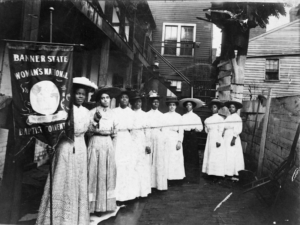
Nine African-American women gather for the Banner State Woman’s National Baptist Convention in 1915 (Library of Congress Prints and Photographs Division Washington, D.C. 20540 USA)
(Smithsonian) In the fall of 1916, four years before the 19th Amendment would make it unconstitutional to deny voting rights on the basis of sex, African-American women in Chicago were readying to cast their first ballots ever for President. The scenes in that year of black women, many of them the daughters and granddaughters of former slaves, exercising the franchise, was as ordinary as it was unexpected.
Theirs was a unique brand of politics crafted at the crossroads of racism and sexism. African-American women had always made their own way. In Chicago, they secured a place at the polls by way of newly enacted state laws that, over 25 years, extended the vote to the women of Illinois, gradually, unevenly and without regard to color. The real story, however, is an older one that stretches across generations of black women’s ambition and activism. It only sometimes intersects with better-known tales of how white women campaigned for their political rights. And yes, sometimes black and white women clashed. Still, the history of black women and the vote is one about figures who, though subjected to nearly crushing political disabilities, emerged as unparalleled advocates of universal suffrage in its truest sense.
Their story begins in an unexpected place—the church. For black women, church communities were central sites for developing their sense of rights and how then to organize for them. No one understood this better than Julia Foote, born in 1823 and who, at the age of 18, felt herself called to preach in the African Methodist Episcopal (A.M.E.) Church. By the 1840s, Foote was a leader in a churchwomen’s movement which demanded that they, like men, should be entitled to occupy pulpits and interpret the scriptures. (more)
Why FDR Didn’t Support Eleanor Roosevelt’s Anti-Lynching Campaign
President Franklin D. Roosevelt feared losing Southern support for his New Deal legislation.
(History) In December 2018, the U.S. Senate passed a federal anti-lynching bill for the first time. The significant milestone is preceded by at least 240 failed attempts since 1901 to pass any bill or resolution mentioning lynching in Congress. These attempts to outlaw lynching peaked during Franklin D. Roosevelt’s presidency. First Lady Eleanor Roosevelt was a strong supporter of anti-lynching legislation, but FDR never supported it for fear of alienating white Democratic voters in the south.
Eleanor joined the NAACP during FDR’s first term in 1934 and began working with leader Walter White to outlaw lynching. This work earned her a lot of enemies, as well as some death threats. Critics of her husband like J. Edgar Hoover spread racist rumors that she was mixed race; and in the 1950s, the Ku Klux Klan put a $25,000 bounty on her head. Her work also caused a rift between her and her husband, whom she could never convince to support her cause.
Those bills he wanted to pass to keep America from collapsing were part of the New Deal. At the time, “the southern Democrats in the Senate are holding the New Deal hostage and refusing to move on New Deal issues unless the rest of the Democratic party backs off the anti-lynching bills,” says Eric Rauchway, a history professor at the University of California, Davis. (more)
TIPHC Bookshelf
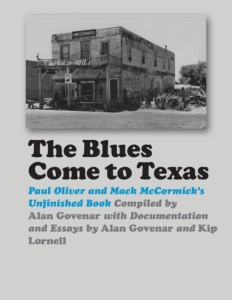 Published scholarship on black history in Texas is growing and we’d like to share with you some suggested readings, both current and past, from some of the preeminent history scholars in Texas and beyond. We invite you to take a look at our bookshelf page – including a featured selection – and check back as the list grows. A different selection will be featured each week. We welcome suggestions and reviews. This week, we offer, “The Blues Come to Texas: Paul Oliver and Mack McCormick’s Unfinished Book,” by Paul Oliver and Mack McCormick, compiled by Alan B. Govenar, contributions by Kip Lornell.
Published scholarship on black history in Texas is growing and we’d like to share with you some suggested readings, both current and past, from some of the preeminent history scholars in Texas and beyond. We invite you to take a look at our bookshelf page – including a featured selection – and check back as the list grows. A different selection will be featured each week. We welcome suggestions and reviews. This week, we offer, “The Blues Come to Texas: Paul Oliver and Mack McCormick’s Unfinished Book,” by Paul Oliver and Mack McCormick, compiled by Alan B. Govenar, contributions by Kip Lornell.
From October 1959 until the mid-1970s, Paul Oliver and Mack McCormick collaborated on what they hoped to be a definitive history and analysis of the blues in Texas. Both were prominent scholars and researchers—Oliver had already established an impressive record of publications, and McCormick was building a sprawling collection of primary materials that included field recordings and interviews with blues musicians from all over Texas and the greater South.
Despite being eagerly awaited by blues fans, folklorists, historians, and ethnomusicologists who knew about the Oliver-McCormick collaboration, the intended manuscript was never completed.
In 1996, Alan Govenar, a respected writer, folklorist, photographer, and filmmaker, began a conversation with Oliver about the unfinished book on Texas blues. Subsequently, Oliver invited Govenar to assist him, and when Oliver became ill, Govenar enlisted folklorist and ethnomusicologist Kip Lornell to help him contextualize and document the existing manuscript for publication.
“The Blues Come to Texas” presents an unparalleled view into the minds and methods of two pioneering blues scholars.
This Week in Texas Black History
Apr 14
 On this day in 1935, Julius “Jay” Parker, Jr. was born in New Braunfels. Parker attended Prairie View A&M University where he completed the Reserve Officers Training Corps curriculum in 1955. Parker rose to the rank of major general and became the highest ranking African-American Military Intelligence Officer in the history of the U.S. Army. He is also a direct descendant of Quanah Parker, the last chief of the Comanche nation.
On this day in 1935, Julius “Jay” Parker, Jr. was born in New Braunfels. Parker attended Prairie View A&M University where he completed the Reserve Officers Training Corps curriculum in 1955. Parker rose to the rank of major general and became the highest ranking African-American Military Intelligence Officer in the history of the U.S. Army. He is also a direct descendant of Quanah Parker, the last chief of the Comanche nation.
Apr 14
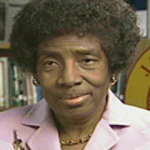 Born in Houston on this day in 1938, Gloria Dean Randle Scott became the first African-American president of the Girl Scouts of America. A civic and educational leader, she took the post in 1975. Scott graduated from Jack Yates High School and received post graduate degrees, including education, from Indiana University. She had been a Junior Girl Scout at and later served as President of the Negro Girl Scout Senior Planning Board. In 1987, she was selected as president of Bennett College, in Greensboro, North Carolina. In 2001, she returned to Texas and was very active in the Corpus Christi community, including the Black Chamber of Commerce.
Born in Houston on this day in 1938, Gloria Dean Randle Scott became the first African-American president of the Girl Scouts of America. A civic and educational leader, she took the post in 1975. Scott graduated from Jack Yates High School and received post graduate degrees, including education, from Indiana University. She had been a Junior Girl Scout at and later served as President of the Negro Girl Scout Senior Planning Board. In 1987, she was selected as president of Bennett College, in Greensboro, North Carolina. In 2001, she returned to Texas and was very active in the Corpus Christi community, including the Black Chamber of Commerce.
Apr 16
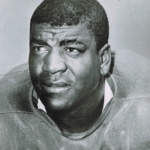 National Football League defensive back Dick “Night Train” Lane was born in Austin on this day in 1928. After serving in the Army during World War II and the Korean War, Lane was signed as a free agent in 1952 with the Los Angeles Rams, though he’d only played at Austin Anderson High School and Scottsbluff (Neb.) Junior College. During his 13-year career, Lane was known as ferocious, intimidating hitter and was responsible for the banishment of the clothesline tackle. Lane’s 14 interceptions in 1952 still stands as an NFL record for rookies. In 1969, just four years after his retirement, he was voted the best cornerback in the first 50 years of the NFL, and in 1974 was inducted to the Pro Football Hall of Fame. In 2001, he was inducted into the Texas Sports Hall of Fame.
National Football League defensive back Dick “Night Train” Lane was born in Austin on this day in 1928. After serving in the Army during World War II and the Korean War, Lane was signed as a free agent in 1952 with the Los Angeles Rams, though he’d only played at Austin Anderson High School and Scottsbluff (Neb.) Junior College. During his 13-year career, Lane was known as ferocious, intimidating hitter and was responsible for the banishment of the clothesline tackle. Lane’s 14 interceptions in 1952 still stands as an NFL record for rookies. In 1969, just four years after his retirement, he was voted the best cornerback in the first 50 years of the NFL, and in 1974 was inducted to the Pro Football Hall of Fame. In 2001, he was inducted into the Texas Sports Hall of Fame.
Apr 17
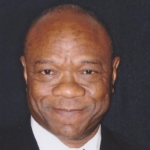 Two-time All-Pro running back Delvin Williams was born on this day in 1951 in Houston. Williams graduated from Kashmere Gardens High School in 1970 and was a Parade Magazine All-American and one of the most sought after prep running backs in the country, recruited by every major college football program. Williams chose the University of Kansas and four years later became a second round pick of the San Francisco Forty-Niners. He thrived in the National Football League for eight seasons, becoming the first player in NFL history to rush for 1,000 yards in a season for two different teams (Niners and Miami Dolphins). Williams was also the first player in NFL history to set rushing records for two different teams, and to be named to the Pro Bowl for both an AFC & NFC team.
Two-time All-Pro running back Delvin Williams was born on this day in 1951 in Houston. Williams graduated from Kashmere Gardens High School in 1970 and was a Parade Magazine All-American and one of the most sought after prep running backs in the country, recruited by every major college football program. Williams chose the University of Kansas and four years later became a second round pick of the San Francisco Forty-Niners. He thrived in the National Football League for eight seasons, becoming the first player in NFL history to rush for 1,000 yards in a season for two different teams (Niners and Miami Dolphins). Williams was also the first player in NFL history to set rushing records for two different teams, and to be named to the Pro Bowl for both an AFC & NFC team.
Apr 18
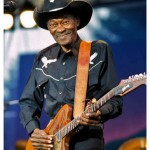 On this day in 1924, Clarence “Gatemouth” Brown was born in Vinton, Louisiana. Brown was raised in Orange, Texas where he learned to play several instruments beginning with fiddle at age 5, followed by guitar, mandolin, viola, harmonica, and drums. Brown got his nickname from a high school teacher who said he had a voice “like a gate.” He made dozens of recordings in the 1940s and ’50s, including many regional hits – “Okie Dokie Stomp,” “Boogie Rambler,” and “Dirty Work at the Crossroads.” He was nominated six times for Grammy Awards and was awarded one in 1983 in the “Traditional Blues” category for his album, “Alright Again.”
On this day in 1924, Clarence “Gatemouth” Brown was born in Vinton, Louisiana. Brown was raised in Orange, Texas where he learned to play several instruments beginning with fiddle at age 5, followed by guitar, mandolin, viola, harmonica, and drums. Brown got his nickname from a high school teacher who said he had a voice “like a gate.” He made dozens of recordings in the 1940s and ’50s, including many regional hits – “Okie Dokie Stomp,” “Boogie Rambler,” and “Dirty Work at the Crossroads.” He was nominated six times for Grammy Awards and was awarded one in 1983 in the “Traditional Blues” category for his album, “Alright Again.”
Blog: Ron Goodwin, Ph.D., author, PVAMU history professor
Ron Goodwin is an assistant professor of history at Prairie View A&M University. Even though he was a military “brat,” he still considers San Antonio home. Like his father and brother, Ron joined the U.S. Air Force and while enlisted received his undergraduate degree from Texas Lutheran University in Seguin, Texas. After his honorable discharge, he completed graduate degrees from Texas Southern University. Goodwin’s book, Blacks in Houston, is a pictorial history of Houston’s black community. His most recent book, Remembering the Days of Sorrow, examines the institution of slavery in Texas from the perspective of the New Deal’s Slave Narratives.
Recent Posts
The Everlasting Light
Ye are the light of the world. A city that is set on an hill cannot be hid. Neither do men light a candle, and put it under a bushel, but on a candlestick; and it givith light unto all that are in the house. Let your light so shine before men, that they may see your good works, and glorify your Father which is in heaven. — Matthew 5: 14-16
This is the month set aside to honor…(more)
The Return of the Silent Majority
Fifty years ago, in January 1969, Richard Nixon was sworn in as the thirty-seventh president of the United States. His legacy as President was marred by the Watergate investigations and his eventual resignation from office which overshadowed the way in which he won the office. His central campaign rhetoric was designed to garner support from white Southerners (otherwise known in history as the “Silent Majority”) whose racial beliefs leaned heavily towards the support of white…(more)
Submissions wanted
Historians, scholars, students, lend us your…writings. Help us produce the most comprehensive documentation ever undertaken for the African American experience in Texas. We encourage you to contribute items about people, places, events, issues, politics/legislation, sports, entertainment, religion, etc., as general entries or essays. Our documentation is wide-ranging and diverse, and you may research and write about the subject of your interest or, to start, please consult our list of suggested biographical entries and see submission guidelines. However, all topics must be approved by TIPHC editors before beginning your research/writing.
We welcome your questions or comments. Please contact Michael Hurd, Director of TIPHC, at mdhurd@pvamu.edu.

